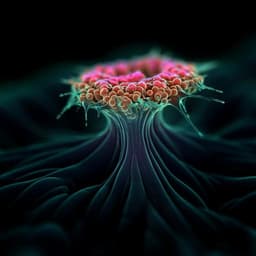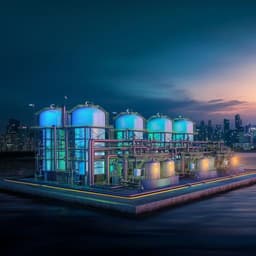
Biology
An on-demand, drop-on-drop method for studying enzyme catalysis by serial crystallography
A. Butryn, P. S. Simon, et al.
Discover how cutting-edge serial femtosecond crystallography has been transformed by a groundbreaking drop-on-drop sample delivery system that allows for enzyme-catalyzed reactions in microcrystal slurries. This innovative method, developed by a team of researchers including Agata Butryn and Philipp S. Simon, promises to enhance our understanding of enzyme reactions with small molecule substrates.
~3 min • Beginner • English
Introduction
Time-resolved serial femtosecond crystallography (tr-SFX) enables the observation of protein structural dynamics by synchronizing ultrafast XFEL pulses with reaction initiation. Although optical triggering has enabled sub-picosecond to longer timescale studies, few enzymes are intrinsically light-activated, limiting general applicability. Many biologically relevant macromolecular reactions depend on ligand diffusion into active sites, motivating development of broadly applicable mixing strategies that preserve crystal order while enabling controlled, rapid initiation. Enzyme catalysis under near-physiological conditions via tr-SFX/tr-SSX is an emerging approach to understand mechanisms and inform therapeutic development. Theory indicates that with suitably small crystals (<5 µm), substrate diffusion can occur on millisecond timescales—faster than many enzymatic turnovers—permitting substrate occupancy before significant reaction proceeds. However, existing mixing approaches face challenges: liquid jets consume large sample volumes and ligands; longer exposures at synchrotrons can limit time resolution when coupled with reaction initiation; and implementing rapid, reliable, non-damaging mixing is technically demanding. This study introduces an on-demand, droplet-based mixing strategy, extending the drop-on-tape method to deliver bursts of substrate microdrops onto crystal-containing drops (drop-on-drop), aiming to achieve sub-second initiation with low sample consumption and high versatility.
Literature Review
Prior time-resolved SFX largely leveraged light-inducible systems and caged substrates or engineered photocaged residues, which are system-specific and not general solutions. Mix-and-diffuse strategies at XFELs and synchrotrons have probed multisecond to sub-second delays but often rely on continuous liquid jets with high sample and ligand consumption. Alternative low-consumption methods include depositing samples on moving tapes (drop-on-tape) and the LAMA technique, where substrates are dispensed onto preloaded chips. These methods improved versatility and hit rates but still face diffusion and timing constraints. The present work builds directly on drop-on-tape by adding a second, synchronized dispenser to induce collision-driven mixing within droplets, targeting faster equilibration than diffusion alone while minimizing consumption.
Methodology
Overview and setup: The drop-on-drop system uses an acoustic droplet ejector (ADE) to deposit nanoliter-sized microcrystal slurry drops onto a moving Kapton tape synchronized to the XFEL master clock (30 Hz). A piezoelectric injector (PEI) dispenses bursts of ~120 pL substrate droplets (100 µm orifice) at 1–30 kHz to collide with the larger crystal-containing drops at a relative velocity of ~1–2 m/s. The Kapton tape speed is adjustable (10–600 mm/s), setting reaction delays of ~0.1–6 s from mixing to X-ray interaction. The PEI timing is synchronized via TTL trigger from ADE, and overlap is optimized by camera-assisted manual delay adjustment. Both crystal and substrate solutions are filtered and cooled (4 °C) prior to dispensing. Experiments were performed at SACLA BL2; hutch temperature was ~34–36 °C.
Simulations and dye mixing validation: Numerical reaction–mass-transfer simulations examined Ca2+ ligand diffusion and binding in a three-dimensional droplet system using calcium-sensitive fluorescent dyes. Stationary picoliter droplets mixing by diffusion alone led to 1–2 s equilibration. Introducing high-frequency, high-velocity collisions of multiple small droplets distributed over the larger drop surface decreased predicted equilibration to <1 ms, reducing constraints from overall drop size. Proof-of-principle experiments with the same dye system measured fluorescence rise components with rise times <100–150 ms—about an order of magnitude faster than diffusion-only simulations—confirming accelerated, collision-induced mixing.
Protein systems and crystallization: Two enzyme systems were used. Hen egg white lysozyme (HEWL) microcrystals (3–5 µm) were grown by rapid-mixing batch, with slurries at ~10^7 crystals/mL (0.6 and 2 s datasets) or concentrated threefold (resting and 0.2 s). CTX-M-15 β-lactamase was expressed in E. coli, purified (His-tag removed with 3C protease), and crystallized by seeding; microcrystals (rods, 5 µm width, 10–20 µm length) were harvested and concentrated to ~8×10^7 crystals/mL.
Mixing and reaction initiation: Substrates were N-acetyl-D-glucosamine (GlcNAc; 226 mM stock) for HEWL and ertapenem (0.8 M stock) for CTX-M-15. Substrate bursts were synchronized to ADE droplets to minimize consumption. For HEWL, 2–6 drops of GlcNAc yielded final concentrations 16.7–43.7 mM. For CTX-M-15, four drops of ertapenem produced ~110.3 mM final concentration. Tape positions and speeds set delay times of 0.2, 0.6, and 2 s for HEWL, and 0.6 and 2 s for CTX-M-15. Additional fixed-target SSX at synchrotron provided a 10 min CTX-M-15 time point.
Data collection and processing: SFX data at SACLA were identified with Cheetah and processed with cctbx.xfel and DIALS. HEWL data were indexed in P41212, merged with cxi.merge, and refined with Phenix/Coot; reference models and resolution cut-offs followed standard criteria (CC1/2, multiplicity, I/σ(I)) and PDB-REDO paired refinement tests. CTX-M-15 data were processed in P212121; SACLA and DLS datasets were merged separately due to unit cell differences. Ligand placement was guided by isomorphous difference maps Fo(time point)−Fo(resting) and polder OMIT maps; restraints were generated via Grade (GlcNAc) and eLBOW (ertapenem). Deposited PDB IDs include HEWL (7BHK, 7BHL, 7BHM, 7BHN) and CTX-M-15 (7BH3, 7BH4, 7BH5, 7BH6, 7BH7).
Key Findings
- Collision-induced mixing in drop-on-drop accelerated equilibration dramatically relative to diffusion-only predictions: simulations indicated <1 ms equilibration with high-frequency (kHz) substrate drop collisions vs 1–2 s by diffusion; fluorescence experiments showed components rising within <100–150 ms, roughly an order of magnitude faster than diffusion-only expectations.
- Time-resolved serial crystallography confirmed rapid ligand binding in crystals:
• HEWL with GlcNAc: At 0.6 s and 2 s after adding 2–6 substrate drops (final 16.7–43.7 mM), isomorphous difference and polder OMIT maps showed clear GlcNAc density at the active site, consistent with known binding positions; 0.2 s resembled resting state.
• CTX-M-15 with ertapenem: No clear active-site changes at 0.6 s after four drops (final ~110.3 mM), but at 2 s, difference density adjacent to Ser70 enabled modeling an acyl–enzyme complex with ring-opened ertapenem, corroborated by polder OMIT maps and consistent with a presoaked control.
- The system achieved sub-second to few-second time resolution (0.1–6 s adjustable via 10–600 mm/s tape speeds) with low consumption: six structures required only 84–258 µL ligand and 162–420 µL microcrystal slurry; for example, the 0.6 s HEWL dataset used ~0.7 µmol (9.5 mg) protein and 0.18 mL of 0.226 M ligand (~41 µmol).
- Operational parameters: PEI substrate drops ~120 pL dispensed at up to 30 kHz, impacting ADE-produced nanoliter crystal drops at ~1–2 m/s; system accommodates 5–100 µm crystals by adjusting droplet sizes and avoids restrictive nozzles for crystal-laden drops.
- The method is versatile and readily transferable to synchrotron SSX, enabling expanded temporal coverage (projected 50 ms to 10 s with environmental control) and broad applicability to enzyme–small molecule systems.
Discussion
The study addresses the need for a general, low-consumption, and rapid initiation method for time-resolved crystallography of non–light-activated enzymes. By leveraging on-demand droplet collisions, the approach induces internal hydrodynamic flows that significantly accelerate mixing within microdroplets, thereby overcoming diffusion limitations that typically restrict temporal resolution. Experimental dye kinetics and tr-SFX structural data validate that substrates can reach and occupy active sites on sub-second timescales relative to enzymatic turnover, enabling capture of ligand-bound states and catalytic intermediates. Differences observed between HEWL (clear binding by 0.6–2 s) and CTX-M-15 (acyl–enzyme observed at 2 s but not 0.6 s) highlight the influence of system-specific kinetics and underscore the importance of tunable delay times. Low sample and ligand consumption, combined with high hit rates and adaptability to varying crystal sizes, make the method practical for a wide range of targets. The demonstrated compatibility with XFELs and potential transfer to synchrotrons (especially next-generation pink/bright beamlines with sub-ms exposures) suggests broad relevance for dynamic structural biology and studies of enzyme–drug interactions.
Conclusion
This work introduces and validates a drop-on-drop, on-demand mixing strategy for serial crystallography that accelerates intra-droplet mixing, enabling sub-second to few-second time-resolved studies of enzyme catalysis with low sample consumption. Proof-of-principle results capture ligand binding in HEWL and formation of an acyl–enzyme intermediate in CTX-M-15 within seconds of mixing. The system is flexible (adjustable tape speeds, droplet numbers/sizes), accommodates a wide crystal size range, and can be extended with humidity and temperature control. Future directions include deployment at synchrotron sources to expand access beyond XFEL facilities, exploration of broader delay times (approximately 50 ms to 10 s), optimization for diverse enzyme–substrate pairs, and integration with advanced beamlines to further improve temporal resolution.
Limitations
The study demonstrates feasibility on two enzyme systems and a limited set of conditions at SACLA; broader generality across targets and reaction times requires further testing. For CTX-M-15, no active-site changes were detected at 0.6 s, indicating that reaction kinetics and diffusion into crystals can still limit observable states at shorter delays. Data from different facilities required separate treatment due to unit cell differences, complicating direct comparisons. Time resolution remains coupled to transport and mixing parameters (tape speed, dispenser positioning), and environmental control (e.g., humidity, temperature) was not fully explored here but is anticipated to impact performance.
Related Publications
Explore these studies to deepen your understanding of the subject.







